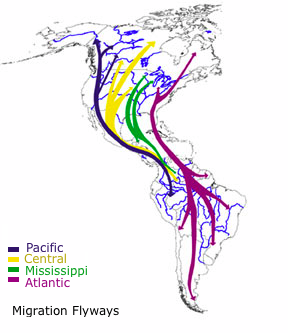Songbirds
Abut 50% of the songbirds in New Jersey migrate south in the winter.
Many of these birds are insectivores; they eat mainly insects. (Most insects do not survive the North American winters except in larval or egg forms.)
These include, flycatchers, wrens, thrushes, vireos, warblers and sparrows.
However, Many species of migratory songbirds that
are primarily insectivorous during the breeding
season consume large amounts of fruit
during autumn migration. See NY Times report on URI article.
These birds remain on their non-breeding (wintering) grounds until April.
They migrate at night.
See:
What is migration? | njaudubon.org
BWB-ASF Library: Bird Migration Facts | Zoological Society of Milwaukee
Raptors
Migration:
 Broad Broad-winged hawks migration:
Broad Broad-winged hawks migration:
Sept. 10 - Lake Ontario
Sept. 15 - Mass.
Sept. 17 - NJ and PA
Oct. -1 - Texas
They may not fly on some days because of weather or the need to refuel so the average from above is 65-90 miles per day.
Red-Tails and others tend to be later.
Hawks will fly around 10 hours per day and travel from 100 to 250 miles.
Ducks and geese might travel as much as 400 to 500 miles per day.
Many species of wading and swimming birds are able to feed at all hours, they migrate either by day or night. Soaring birds such as broad-winged hawks only migrate during the day to take advantage of thermals.
In some species of raptors, every individual migrates. In other species, only part of the population migrates and some individuals remain on the breeding grounds. Other species are completely sedentary. Overall, about 45 percent of all raptor populations migrate.
Raptors fly from 29-40 MPH at an elevation of 700 - 4,000 ft.
Migration may have as much to do with availability of food as weather.
See also Migration Path | Hawk Mountain Sanctuary
Wintering locations:
| Broad-wings | Central America and N. South America |
| Sharp-shinned | Southern US, Central America |
| Coopers | Gulf coast, Mexico to Honduras |
| Kestrel | Coastal Mexico, Central America |
| Ospreys, Peregrine falcons | Pacific coast of S. America & Bolivia |
See:
Chimney Rock Hawk Watch
Flyways And Byways at 10000birds.com
New Jersey Osprey Project
Tails of Birding: Where Do the Hawks Go?
Random House Atlas of Bird Migration: Tracing the Journey's of the World's Birds, 1995
Return to Environment
last updated 22 Apr 2014
|
